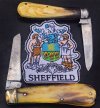- Joined
- Dec 2, 2005
- Messages
- 65,546
Life is good 






I'll be number one for the Coin Pocket Lamb... Kidding of courseIf we can get a thousand orders together, it might be cost-effective to get new patterns made
Thanks Jack!Nice pic Jon, hope you're feeling better soon mate
That is all perfectly true Christian, if a Lambsfoot loses its point or straight edge it will lose the superior place it has in the pantheon of blade styles (though it may still be more useful than some)However, if the tip of a Clip blade gets rounded it will not work so well, yet it is still a Clip blade. What else would we call a worn Lambsfoot blade, or one that has been damaged or badly sharpened. Unless it has been drastically altered, like the example I showed, I think we'd still refer to it as a worn Lambsfoot blade, rather than inventing some new name for it. This one here (a Howarth gifted to me by Paul Mason) has lost its tip, but it is still clearly a Lambsfoot, albeit one which has been injured


A fair point, and that’s why I think Jack’s caveat of “albeit a worn lambsfoot” is both important and useful to the discussion. There is utility in retaining an object’s heritage in its name, even if some of the traits associated with that name have passed.
A treaded tire that has worn through all of its tread would be a now-bald treaded tire to me, rather than a slick. The latter being a tire that as purposely made without tread. If I were in the market for slicks, I’d certainly care about the difference.
I do appreciate the question and discussion. It’s a bit of a brain bending topic to ponder over morning coffee.
Intelligent question, well asked, and well answered by our regulars I thinkI love to see different jigging styles, and will sometimes buy an old knife, which is otherwise ruined or badly worn, just for the jigging. Symmetrical jigging can look very good indeed, but the asymmetrical jigging has greater character in my opinion, showing (or giving the impression) that it was done by hand. If we look at this knife of Harvey's for example, a particularly fine example of old jigging in my opinion, there is so much going on there, even evidence that it was saw-cut.

At the other end of the spectrum, in my opinion, is the jigged bone A.Wright & Son currently use (they buy in the bone pre-jigged). This really does very little for me I'm afraid, and I hope that one day they can produce knives with more characterful jigging

Thanks for sharing your thoughts guys. I only ask because as I was admiring my WCLF I thought that I had better be fastidious in my sharpening efforts. I won't like it as much without its straight edge nor its fine point.
That's a downside to the lambsfoot I suppose. I don't think it ages as well as other patterns.
It's probably unfair, but that second example is akin to a child's drawing with crayons.
 I'm not sure the Lambsfoot ages any worse than other patterns though, the point of a Wharncliffe blade is more susceptible to accidental breakage and wear and tear I think, Clips can lose their belly or end up as a recurve. The Sheepsfoot has more steel of course, but how many folks these days sharpen a knife to the point they'll wear it out (the good thing about the Sheepsfoot is that it will probably end up as a Lambsfoot!)? I've seen numerous heavily used Lambsfoot blades, which while they've lost a lot of steel, still have a point and a straight edge
I'm not sure the Lambsfoot ages any worse than other patterns though, the point of a Wharncliffe blade is more susceptible to accidental breakage and wear and tear I think, Clips can lose their belly or end up as a recurve. The Sheepsfoot has more steel of course, but how many folks these days sharpen a knife to the point they'll wear it out (the good thing about the Sheepsfoot is that it will probably end up as a Lambsfoot!)? I've seen numerous heavily used Lambsfoot blades, which while they've lost a lot of steel, still have a point and a straight edge  I think you ARE fastidious in your sharpening efforts my friend!
I think you ARE fastidious in your sharpening efforts my friend! 

I've never heard of lacto-fermented peppers. Is it for preserves or a very spicy hard cider?
Oh, I'm sure it would induce a patina. We may need to do an experiment to see how it compares to regular old vinegar based pickled peppers.One thing I haven't tested, though, is to what extent the finished brine tends to induce a patina on carbon steel. I know you're a fan of slicing pickled jalapenos to help a patina get going. I wonder if these will have a similar effect...
Oh, I'm sure it would induce a patina. We may need to do an experiment to see how it compares to regular old vinegar based pickled peppers.
As to the discussion about what to call a worn blade, maybe that's why the old knives had "real lamb foot" etchings. So everyone would know what they were, even after sharpening damage and wear.
Riddle me this... should a lambsfoot knife still be considered a lambsfoot once its tip gets rounded over? Wouldn't it just be some sort of wonky spearpoint by then?
Enjoyable discussion Christian, I'm glad you quoted Greg's post as I missed it beforeI'm not sure the Lambsfoot ages any worse than other patterns though, the point of a Wharncliffe blade is more susceptible to accidental breakage and wear and tear I think, Clips can lose their belly or end up as a recurve. The Sheepsfoot has more steel of course, but how many folks these days sharpen a knife to the point they'll wear it out (the good thing about the Sheepsfoot is that it will probably end up as a Lambsfoot!)? I've seen numerous heavily used Lambsfoot blades, which while they've lost a lot of steel, still have a point and a straight edge
I think you ARE fastidious in your sharpening efforts my friend!

LOL! Yep!

As to the discussion about what to call a worn blade, maybe that's why the old knives had "real lamb foot" etchings. So everyone would know what they were, even after sharpening damage and wear.
I get your point (see what I did there?) but it wouldn't take much effort to repoint (did it again) it. The point (again) might be proud of the frame but pointy (again) none the less.



BF membership is inexpensive, great value, and will allow you to receive private messages from other members


At the other end of the spectrum, in my opinion, is the jigged bone A.Wright & Son currently use (they buy in the bone pre-jigged). This really does very little for me I'm afraid, and I hope that one day they can produce knives with more characterful jigging

Finding them is an archeological adventure.
Just to Compare. Small (Pruner); Standard; Big Un


Thanks Mike!!It was Country Thunder Alberta in Calgary. Got to sleep at home each night instead of camping out
Wonderful vintage cutlery, Harvey!!Jack Black - Thank you kindly for the nice words. every one of your images in your current posts are delightful.
The Guardian pages have taught me that Sheffield Cutlery, with exceptions like your SFOs, etc, isn’t what it used to be. Many of the Cutlery skill sets, like Jigging has faded, with fewer knowing how to do it. Like other Vintage patterns, finding these gems is what drives me to hunt for them. I rarely carry or use the older Lambsfoot knives. Losing the profile means that somebody from wayback actually used it. The jigging is unlike anything seen today. I’m in the camp that finds the old Sheffield jigging patterns sublime. I love the older Sheffield Lambsfoot knives(with or without jigging). That goes equally for all the older Sheffield patterns. Finding them is an archeological adventure.
Good Morning Guardians.
View attachment 1182174

